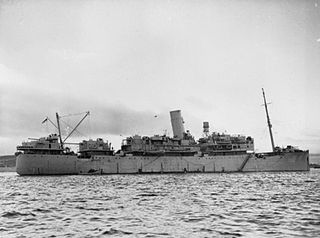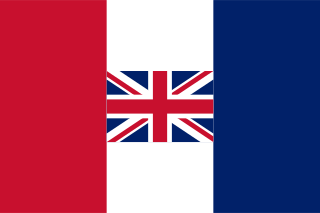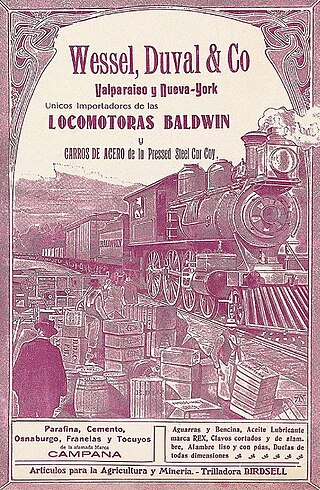
An ocean liner is a type of passenger ship primarily used for transportation across seas or oceans. Ocean liners may also carry cargo or mail, and may sometimes be used for other purposes. The Queen Mary 2 is the only ocean liner still in service to this day, serving with Cunard Line
Holland America Line N.V. (HAL) is an American-owned cruise line, a subsidiary of Carnival Corporation & plc headquartered in Seattle, Washington, United States.

American President Lines, LLC, is an American container shipping company that is a subsidiary of French shipping company CMA CGM. It operates an all-container ship fleet, including nine U.S. flagged container vessels.

HMS Cheshire was a passenger ship that was built in Scotland in 1927 and scrapped in Wales in 1957. She belonged to Bibby Line, which ran passenger and cargo services between Rangoon in Burma and various ports in Great Britain, via the Suez Canal and Gibraltar. The Admiralty requisitioned her in 1939 and had her converted into an armed merchant cruiser (AMC). She was converted into a troopship in 1943, and returned to civilian service in 1948.

CP Ships was a large Canadian shipping company established in the 19th century. From the late 1880s until after World War II, the company was Canada's largest operator of Atlantic and Pacific steamships. Many immigrants travelled on CP ships from Europe to Canada. In 1914 the sinking of the Canadian Pacific steamship RMS Empress of Ireland just before World War I became largest maritime disaster in Canadian history. The company provided Canadian Merchant Navy vessels in World Wars I and II. Twelve vessels were lost due to enemy action in World War II, including the RMS Empress of Britain, which was the largest ship ever sunk by a German U-boat.

SM U-151 or SM Unterseeboot 151 was a World War I U-boat of the Imperial German Navy, constructed by Reiherstieg Schiffswerfte & Maschinenfabrik at Hamburg and launched on 4 April 1917. From 1917 until the Armistice in November 1918 she was part of the U-Kreuzer Flotilla, and was responsible for 34 ships sunk (88,395 GRT) and 7 ships damaged.

P. Henderson & Company, also known as Paddy Henderson, was a ship owning and management company based in Glasgow, Scotland and operating to Burma and New Zealand. Patrick Henderson started business in Glasgow as a merchant at the age of 25 in 1834. He had three brothers. Two were merchants working for an agent in the Italian port of Leghorn; the third, George, was a sea captain with his own ship.
The Collins Line was the common name for the American shipping company started by Israel Collins and then built up by his son Edward Knight Collins, formally called the New York and Liverpool United States Mail Steamship Company. Under Edward Collins' guidance, the company grew to be a serious competitor on the transatlantic routes to the British Cunard shipping company.
SS Castilian was a British cargo steamship and is now a dangerous wreck in the Irish Sea off the coast of North Wales. She was built in 1919 to a standard First World War design. In 1943 while carrying munitions she struck rocks off The Skerries, Isle of Anglesey and sank.

Furness Withy was a major British transport business. It was listed on the London Stock Exchange.
USS Hisko (ID-1953) was a tanker that served in the United States Navy from 1917 to 1919.
Counties Ship Management Co. Ltd. (CSM) was an ocean-going merchant shipping company based in the United Kingdom. During the Second World War CSM merchant ships made a substantial contribution to supplying the British war effort, at a cost of 13 ships lost and 163 officers and men killed.

Eagle Oil and Shipping Company was a United Kingdom merchant shipping company that operated oil tankers between the Gulf of Mexico and the UK. Weetman Pearson, 1st Viscount Cowdray founded it as the Eagle Oil Transport Company in 1912 and sold it to Royal Dutch Shell in 1919. It was renamed Eagle Oil and Shipping Company in about 1930, and remained a separate company within the Royal Dutch Shell group until it was absorbed in 1959.
Dart Containerline Co Ltd was a consortium of shipping companies that commenced operations in 1969, thus becoming one of the first container shipping operators.

Lamport and Holt was a UK merchant shipping line. It was founded as a partnership in 1845, reconstituted as a limited company in 1911 and ceased trading in 1991.

Wessel, Duval & Co. was founded in Boston, Massachusetts in 1825 Augustus Hemenway (1805-1876) as Hemenway & Co.. Augustus Hemenway started the shipping company to move his timber products to markets. Augustus Hemenway had timberland in Maine and started his schooner shipping company to take timber to Eastcoast ports. Later he opened a sugar plant in Cuba, his ships would take lumber to Cuba and bring back sugar. Next, he expanded his timber products to Argentina and other Western South American ports. By 1828 the company expanded to Valparaiso, Chile. Augustus Hemenway married into a Boston merchant family, marrying Mary Tileston (1820-1894) in 1840. In 1865 Héctor Beéche (?-1914) became a partner in the firm and a subsidiary company, Wessel, Duval y Cía, was founded in Chile by Charles P. Hemenway, Augustus's brother. Charles had acted on Augustus' behalf in other matters as needed and became a partner in 1870. T. Quincy Browne became a partner in 1870 also and for a few years the firm was called Hemenway & Browne. In 1875 William Muller joined as a partner, the name returned to Hemenway & Co. Augustus Hemenway died in Cuba in 1876. The partnership continued as Hemenway & Co. till 1885. In 1885 Muller retired and Carlos Wolff joined the partnership, the company name was changed to Hemenway, Beeche and Co.. In 1888 Peter "Perdo" M. Wessel (1851-1821) joined the partnership and the company name was changed to Browne, Beeche and Co..

A. H. Bull Steamship Company was a shipping company and passenger liner service founded in New York City in 1902 by Archibald H. Bull (1848-1920). Service started with shipping between New York and Florida. His fleet of ships then added service to other Eastcoast ports. The company is also often called the Bull Lines and the Bull Steamship Line or A. H. Bull & Company. While founded in New York, Bull soon move its headquarter to Peir 5 in Baltimore, Maryland. Bull Lines main Eastcoast ports were: Baltimore, Charleston, Philadelphia, Tampa and Norfolk, Virginia. Oversea ports: Porto Rico, Antwerp, Bordeaux, Hamburg, Bremen, Copenhagen, and West Africa. Bull Steamship Line supported the US war effort for both World War I and World War II, including the loss of ships.
Sword Line Inc. was a steamship company founded by Charilaos "Charles" G. Poulacos and Abbott Abercrombie in New York City in 1933. Sword Line Inc. had shipping routes from Atlantic ports to and Gulf of Mexico ports. Charilaos "Charles" G. Poulacos and Abbott Abercrombie purchased the ship Eastern Sword in 1932. The Eastern Sword was a 3,785-ton cargo ship built in 1920 at the Uraga Dry Dock Co. Ltd, at Uraga, Japan. The ship sank after being hit by a torpedo from German submarine U-162 on May 4, 1942 twelve miles (19 km) off the coast of Georgetown, Guyana. The Eastern Sword had a crew of 38 and only 13 survived the attack. Sword Line Inc. was active in supporting the World War II effort.
HMS Salopian was a motor ship that was built in 1926 as the passenger ship Shropshire. She belonged to Bibby Line, which ran passenger and cargo services between Rangoon in Burma and various ports in Great Britain, via the Suez Canal and Gibraltar. The Admiralty requisitioned Shropshire in 1939, had her converted into an armed merchant cruiser (AMC), and renamed her Salopian. A German U-boat sank her in the Battle of the Atlantic in 1941.














